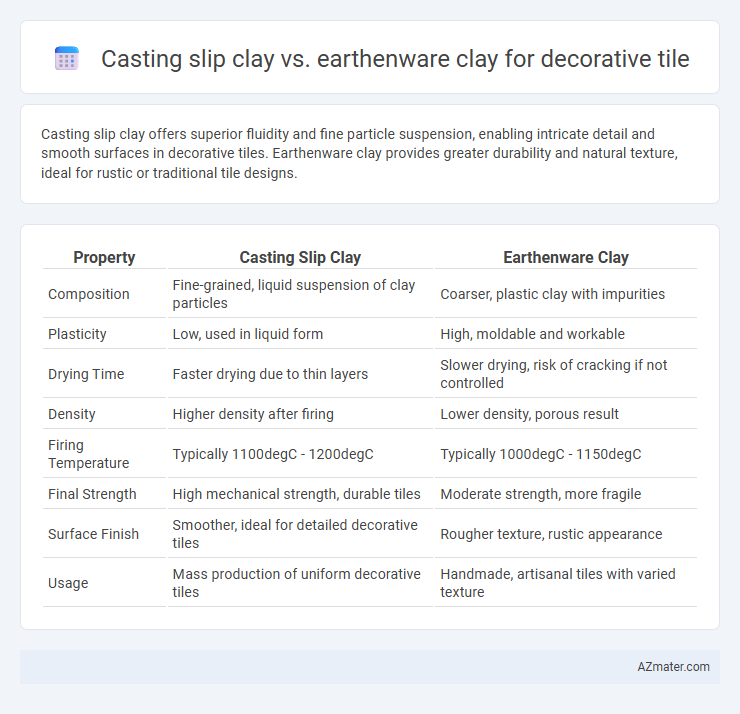Casting slip clay offers superior fluidity and fine particle suspension, enabling intricate detail and smooth surfaces in decorative tiles. Earthenware clay provides greater durability and natural texture, ideal for rustic or traditional tile designs.
Table of Comparison
| Property | Casting Slip Clay | Earthenware Clay |
|---|---|---|
| Composition | Fine-grained, liquid suspension of clay particles | Coarser, plastic clay with impurities |
| Plasticity | Low, used in liquid form | High, moldable and workable |
| Drying Time | Faster drying due to thin layers | Slower drying, risk of cracking if not controlled |
| Density | Higher density after firing | Lower density, porous result |
| Firing Temperature | Typically 1100degC - 1200degC | Typically 1000degC - 1150degC |
| Final Strength | High mechanical strength, durable tiles | Moderate strength, more fragile |
| Surface Finish | Smoother, ideal for detailed decorative tiles | Rougher texture, rustic appearance |
| Usage | Mass production of uniform decorative tiles | Handmade, artisanal tiles with varied texture |
Understanding Casting Slip Clay
Casting slip clay offers superior fluidity and fine particle size, making it ideal for creating detailed, uniform decorative tiles compared to earthenware clay. Its low viscosity allows for precise mold filling, reducing air bubbles and ensuring smooth surfaces with intricate designs. Understanding casting slip clay's composition and behavior enhances the quality and consistency of decorative tile production.
What is Earthenware Clay?
Earthenware clay is a porous, low-fire clay body typically fired between 1,000degC and 1,150degC, known for its rich, earthy tones and ease of shaping, making it ideal for decorative tiles. Unlike casting slip clay, which is liquid and suited for slip casting molds, earthenware clay has a firmer consistency that allows hand-building and detailed carving. Its porous nature requires sealing after firing to ensure durability and water resistance in decorative tile applications.
Key Differences Between Casting Slip and Earthenware Clay
Casting slip clay is a liquid mixture primarily used for casting molds, offering fine detail capture and smooth surface finishes essential for decorative tiles, while earthenware clay is a denser, plastic clay suited for hand-building and throwing, providing greater structural integrity but less detail precision. Casting slip dries faster and can be poured into delicate molds, resulting in thinner, more intricate tile designs compared to the thicker, sturdier tiles made from earthenware clay. Key differences include moisture content, workability, drying time, and texture, all influencing the final decorative tile's appearance and durability.
Suitability for Decorative Tile Production
Casting slip clay offers superior fluidity and fine particle size, enabling intricate mold reproduction ideal for detailed decorative tiles. Earthenware clay, while more plastic and robust, may limit the precision of delicate tile designs due to its coarser texture and higher shrinkage. For decorative tile production focused on intricate patterns and smooth surfaces, casting slip clay provides enhanced suitability over earthenware clay.
Surface Texture and Finish Comparison
Casting slip clay offers a smoother, more refined surface texture ideal for intricate decorative tile designs, achieving a glossy or matte finish with minimal imperfections. Earthenware clay tends to have a coarser texture, resulting in a more rustic, tactile surface that enhances natural finish variations and organic aesthetics. The finer particle size in casting slip promotes better detail precision and uniformity, whereas earthenware's porosity can affect glaze absorption and final surface sheen.
Ease of Shaping and Molding
Casting slip clay offers superior ease of shaping and molding for decorative tiles due to its fluid consistency, allowing for precise detail and smooth surfaces in molds. Earthenware clay, being thicker and less fluid, requires more manual intervention to achieve desired shapes and may not capture fine details as accurately. For intricate and consistent tile production, casting slip clay is generally preferred for its enhanced moldability and ability to reproduce delicate textures.
Firing Temperatures and Effects
Casting slip clay for decorative tiles typically fires at lower temperatures around cone 04 to cone 06 (approximately 1,940degF to 2,130degF), producing smoother surfaces and fine details ideal for intricate designs. Earthenware clay requires firing between cone 06 to cone 04 (about 1,820degF to 2,130degF), which results in more porous, less vitrified tiles with a rustic texture that absorbs more glaze. The firing temperature directly impacts tile durability and glaze adherence, with casting slip clay offering finer detail retention and brighter finishes due to its higher plasticity and finer particle size.
Glazing Compatibility and Results
Casting slip clay offers superior consistency and is ideal for producing fine details in decorative tiles, ensuring more uniform glazing results due to its smooth, dense surface. Earthenware clay, while more porous and less refined, provides traditional charm but may cause uneven glaze absorption, leading to varied finishes and potential defects. For optimal glazing compatibility and consistent aesthetic outcomes, casting slip clay is preferred in decorative tile applications.
Durability and Longevity of Finished Tiles
Casting slip clay offers superior durability and longevity for decorative tiles due to its fine particle size and consistent composition, resulting in denser, less porous tiles resistant to cracking and wear. Earthenware clay, while easier to work with and more porous, tends to produce tiles that are less durable and more susceptible to moisture absorption and surface degradation over time. Choosing casting slip clay ensures finished decorative tiles maintain structural integrity and aesthetic appeal longer, especially in high-traffic or moisture-prone environments.
Choosing the Best Clay for Your Decorative Tile Project
Casting slip clay offers a smooth, fluid consistency ideal for detailed molds and thin, uniform decorative tiles, ensuring minimal shrinkage and fine surface detail. Earthenware clay provides a thicker, more malleable texture suited for hand-building and thicker tiles, with a warmer, rustic finish but higher porosity and potential for cracking. Selecting the best clay depends on your tile's design complexity, desired texture, and firing requirements, making casting slip optimal for precision and earthenware better for robust, textured pieces.

Infographic: Casting slip clay vs Earthenware clay for Decorative tile
 azmater.com
azmater.com